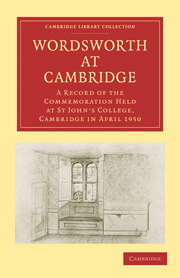 Wordsworth at Cambridge
Wordsworth at Cambridge from The Wordsworth Centenary Celebrations
Published online by Cambridge University Press: 07 September 2010
Where in “our Groves and tributary walks” was Wordsworth's ash tree? The Prelude does not record its position. Nor does Dorothy Wordsworth, who saw the tree when she visited Cambridge some nineteen years after her brother had gone down from St John's. In a letter to Lady Beaumont, dated 14 August in the year 1810, she wrote: “We walked in the groves all the morning, and visited the Colleges. I sought out a favourite ash-tree, which my brother speaks of in his poem on his own life—a tree covered with ivy”. On the same day she wrote to William himself and to Sara Hutchinson: “I was charmed with the walks, found out William's ashtree; the fine willow is dying…”.
Ash trees are not characteristic of the Backs, and there is no reason to suppose that they were ever numerous in the College grounds. The characteristic trees in the grounds of St John's since the seventeenth century have been elms, and they were perhaps at their finest when Wordsworth was an undergraduate—
Lofty Elms,
Inviting shades of opportune recess,
Did give composure to a neighbourhood
Unpeaceful in itself.
They grew beside St John's Ditch (where the New Court now stands), along the Broad Walk, and round the meadow —an arrangement already shown in David Loggan's view and plan of 1688. Some of the elms that Wordsworth knew had certainly been planted in the seventeenth century, and two of those ancient trees survived until the great storm of 14 October 1881, when the last of the “Seven Sisters”, which grew in the meadow, to the east of the Fellows' Garden, were blown down.
To save this book to your Kindle, first ensure [email protected] is added to your Approved Personal Document E-mail List under your Personal Document Settings on the Manage Your Content and Devices page of your Amazon account. Then enter the ‘name’ part of your Kindle email address below. Find out more about saving to your Kindle.
Note you can select to save to either the @free.kindle.com or @kindle.com variations. ‘@free.kindle.com’ emails are free but can only be saved to your device when it is connected to wi-fi. ‘@kindle.com’ emails can be delivered even when you are not connected to wi-fi, but note that service fees apply.
Find out more about the Kindle Personal Document Service.
To save content items to your account, please confirm that you agree to abide by our usage policies. If this is the first time you use this feature, you will be asked to authorise Cambridge Core to connect with your account. Find out more about saving content to Dropbox.
To save content items to your account, please confirm that you agree to abide by our usage policies. If this is the first time you use this feature, you will be asked to authorise Cambridge Core to connect with your account. Find out more about saving content to Google Drive.